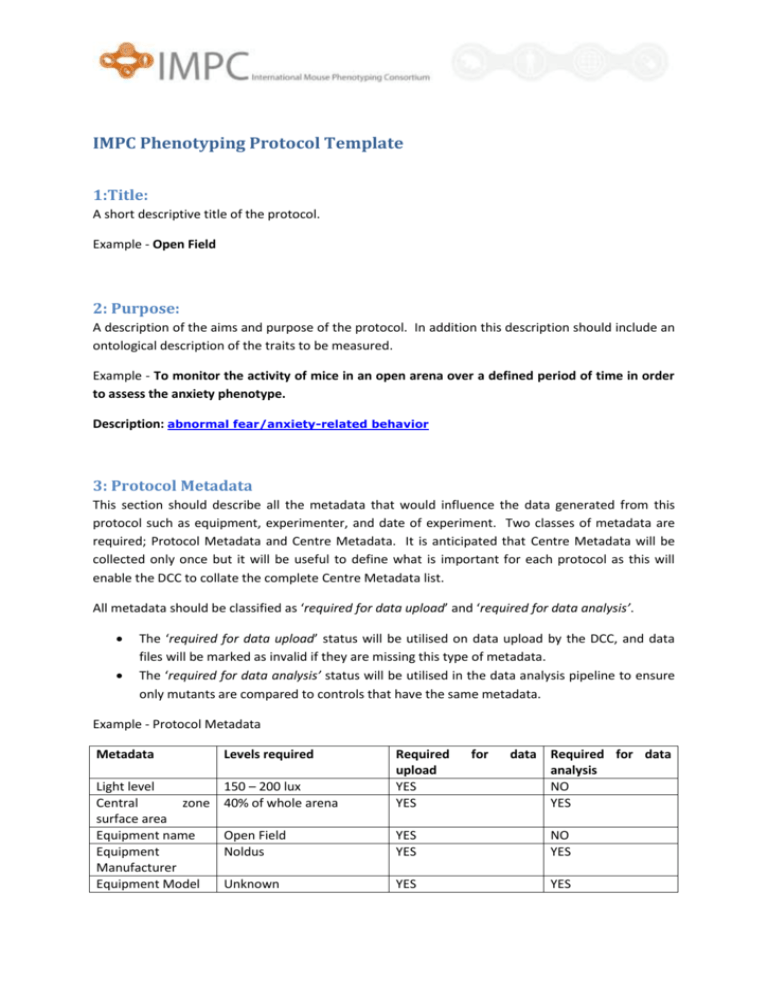Example - Protocol Metadata
advertisement

IMPC Phenotyping Protocol Template 1:Title: A short descriptive title of the protocol. Example - Open Field 2: Purpose: A description of the aims and purpose of the protocol. In addition this description should include an ontological description of the traits to be measured. Example - To monitor the activity of mice in an open arena over a defined period of time in order to assess the anxiety phenotype. Description: abnormal fear/anxiety-related behavior 3: Protocol Metadata This section should describe all the metadata that would influence the data generated from this protocol such as equipment, experimenter, and date of experiment. Two classes of metadata are required; Protocol Metadata and Centre Metadata. It is anticipated that Centre Metadata will be collected only once but it will be useful to define what is important for each protocol as this will enable the DCC to collate the complete Centre Metadata list. All metadata should be classified as ‘required for data upload’ and ‘required for data analysis’. The ‘required for data upload’ status will be utilised on data upload by the DCC, and data files will be marked as invalid if they are missing this type of metadata. The ‘required for data analysis’ status will be utilised in the data analysis pipeline to ensure only mutants are compared to controls that have the same metadata. Example - Protocol Metadata Metadata Levels required Light level Central zone surface area Equipment name Equipment Manufacturer Equipment Model 150 – 200 lux 40% of whole arena Required upload YES YES for data Required for data analysis NO YES Open Field Noldus YES YES NO YES Unknown YES YES 4: Experimental Design The experimental design section of the protocol should describe: Minimum number of mutant animals required to detect the required phenodeviancy. Minimum age of animal the test can be performed on and also the ideal age. Would you expect the results of this test to show sexual dimorphism? 5: Procedure Write the methods and procedures used but do not include centre-specific data entry methods. Example 1. Mice are allowed to acclimatise to the phenotyping room for a period of 30 minutes prior to testing. 2. Light levels within the room are set so that the light intensity within each arena is between 150 – 200 lux. 3. The method of recording is set up with: a. detection parameters appropriate to the coat colour of the mice; b. with each arena defined; c. a peripheral zone, measuring 8cm from the edge of the arena walls; d. a centre zone which takes up 40% of the total surface area of the arena. 4. One mouse is placed in each arena. Mice of different coat colours must be run in separate tests. Males and females must be run in separate tests. 5. A 20 minute period of recording is started after all mice have been placed within an arena. 6. At the end of the 20 minute trial, the mice are removed from the arena and returned to their home cages. 7. Analysis of the recording is done to measure the activity of each mouse in each of the three zones in 5 minute bins. 6: Data Collection Data QC A description of what local QC should be undertaken, and in addition what the DCC should do. Example - Whole arena Resting Time should have a range less than 1200s. IMPC Parameters (+ontology annotations) The parameters to be measured with associated data, such as units and ontology annotations. Example http://empress.har.mrc.ac.uk/viewempress/index.php?pipelineprocedure=EUMODIC+Pipeline+2~ Open-field Data Analysis, annotation and display (+statistics) A description of the analysis including derived parameters and preferred graphs for each parameter. 7: Additional Information






